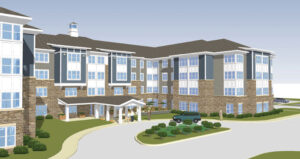From robot dogs to fall sensors—the latest innovations that owners and operators should know about.
The prevalence of proptech has been gaining ground in commercial real estate, though many owners and operators are still slow to adopt. But for one niche poised to experience booming demand, proptech could be a game changer.
Every day, some 10,000 Baby Boomers turn 65, according to U.S. Census data. It’s expected that the generation’s number of retirees will hit 34 million by 2030. These demographic movements have set the stage for what some have dubbed the silver tsunami—a massive influx of potential senior housing residents.
“The COVID-19 pandemic, with all the pain and industry trouble that it has brought, did have some silver linings to it, and one was the increased focus on tech, which in a lot of ways is a positive for operators, residents and family members,” said Ryan Brooks, senior principal for healthy policy and analytics at the National Investment Center for Seniors Housing & Care.
A new generation of tech-savvy senior housing residents coupled with a sea change of thought on cleanliness and air quality in the places people live and work underscores how important it is becoming for owners and operators to update their tech features.
Safety and security
In early 2022, one of the deadliest residential fires in New York City’s history took the lives of 17 residents of a multifamily building in the Bronx. The tragedy led to calls for legislation requiring the installation of sensors that monitor heat levels in buildings remotely.
Sensors such as the ones proposed by federal legislators could become incredibly important in a senior housing setting. In addition to monitoring heat, there are sensors that can help monitor residents for falls by logging gait, speed and stride length, wall-mounted sensors that can monitor an individual’s heart rate and breathing without contact, that can monitor indoor air quality and ones that can detect changes in humidity, temperature, light and water.
“What these things signal to residents and families is that we take the health and well-being of our residents seriously,” Brooks said.Ventilation and air quality have been perhaps the biggest buzzwords in property management since the onset of the pandemic. The increased focus is turning into a long-term trend and there is a slew of related smart tech products in the marketplace, said Jamie James, managing partner at Greensoil Proptech Ventures, a firm that invests in tech for the real estate industry.
The most popular features operators have been implanting include bipolar ionization, microbial cleaners that attach to existing HVAC systems and continuously produce hydrogen peroxide plasma that eliminates viruses such as SARS-CoV-2 and other air contaminants.
“No one takes ventilation seriously and I think they will now,” James said. “We spend all our time indoors, so the quality of that air is important.”
Comfort amid isolation
The ongoing pandemic has further shined a light on the impact isolation can have on an individual’s mental and physical health. “It was finally acknowledged,” said Brooks, adding that senior housing operators have taken the initiative to better connect family members with residents by adopting new technologies.
One of the most high-tech innovations of late that aims to help those struggling with loneliness and isolation are robotic dog and cat companions. These products are on the market and have started popping up in senior housing properties across the country as a way to offer companionship without the responsibility of feeding and walking that a real pet would require. Some of the robotic pets can even speak hundreds of languages and recognize human faces and emotions.
Last fall, The Council on Aging, Southern California, gave out 200 robotic cats and dogs to residents of Orange County-area assisted living communities, focusing in particular on residents of memory care units, according to the Orange County Register. Similar programs have taken place in Florida, Alabama and Minnesota.
“They offer a realistic and interactive play that really does help combat feelings of loneliness among older adults,” Brooks said.
Operational efficiency
It’s no secret that senior housing has been facing many challenges since the start of the global health crisis. One of the most pressing problems has been the ongoing labor shortage, a pain point causing headaches across many industries.
That’s where tech aimed at helping operators streamline their processes can come into play.
Recent innovations have gone beyond what some programs have done before to streamline core functions such as scheduling, human resources and employee attendance. New technology can now go a step beyond and find ways to cut down labor costs.
“I think operators implementing tech solutions to differentiate themselves from regional competition, it doesn’t even have to be major differentiator, even a minor one can be why (a resident) chose a specific operator to move in with,” said Brooks.
An example of a major implementation could be a community having electronic health records of their residents. Having an individual’s entire medical record can help operators use predictive analytics to gain insights into potential risks or help set up communication with families, plan for care and a setting for it. While a major EHR implementation can be expensive, especially if done at scale across a large portfolio, the benefit of preventing adverse outcomes can increase a resident’s length of stay, which is a win for all involved.
“That’s where it’s a real positive for residents and family members,” said Brooks.
By Holly Dutton





